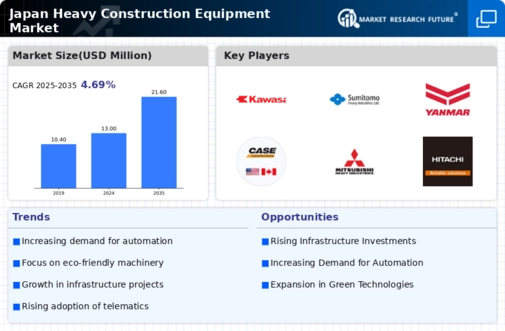Rising Urbanization
The rapid urbanization in Japan is a crucial driver for the heavy construction-equipment market. As cities expand, the demand for infrastructure development increases significantly. Urban areas are projected to grow, necessitating the construction of residential, commercial, and public facilities. This growth leads to a heightened need for heavy construction equipment, such as excavators and bulldozers, to facilitate large-scale projects. In 2025, urbanization in Japan is expected to reach approximately 91%, indicating a substantial market opportunity for construction equipment manufacturers. The heavy construction-equipment market is likely to benefit from this trend. Companies are investing in advanced machinery to meet the demands of urban development.
Aging Infrastructure
Japan's aging infrastructure presents a pressing challenge that drives the heavy construction-equipment market. Many existing structures, including bridges, roads, and tunnels, require significant repairs or complete overhauls. The government has recognized this issue and is likely to allocate substantial funds for infrastructure renewal projects. In 2025, it is estimated that the need for infrastructure investment could exceed ¥20 trillion, creating a robust demand for heavy construction equipment. Companies specializing in construction machinery may find lucrative opportunities in providing the necessary equipment for these renovation projects, thereby stimulating growth in the heavy construction-equipment market.
Environmental Regulations
Stringent environmental regulations in Japan are influencing the heavy construction-equipment market. The government is implementing policies aimed at reducing emissions and promoting sustainable practices in construction. As a result, there is a growing demand for eco-friendly machinery that complies with these regulations. In 2025, it is projected that the market for electric and hybrid construction equipment will grow by 25%, reflecting a shift towards greener alternatives. This trend not only aligns with national sustainability goals but also presents opportunities for manufacturers to innovate and capture a share of the evolving heavy construction-equipment market.
Technological Advancements
Technological advancements are reshaping the heavy construction-equipment market in Japan. Innovations such as automation, telematics, and advanced materials are enhancing the efficiency and safety of construction operations. The integration of smart technologies into heavy machinery allows for real-time monitoring and predictive maintenance, which can reduce downtime and operational costs. In 2025, it is anticipated that the adoption of these technologies will increase by approximately 30%, as companies seek to improve productivity and reduce labor costs. This trend indicates a shift towards more sophisticated equipment, driving demand within the heavy construction-equipment market.
Increased Foreign Investment
Increased foreign investment in Japan's construction sector is a notable driver for the heavy construction-equipment market. As international companies seek to capitalize on Japan's robust economy and infrastructure needs, they are likely to invest in local construction projects. This influx of capital can lead to a surge in demand for heavy construction equipment, as new projects require advanced machinery. In 2025, foreign direct investment in the construction industry is expected to rise by 15%, further stimulating the heavy construction-equipment market. This trend may encourage local manufacturers to enhance their offerings and compete effectively in a growing market.




















Leave a Comment